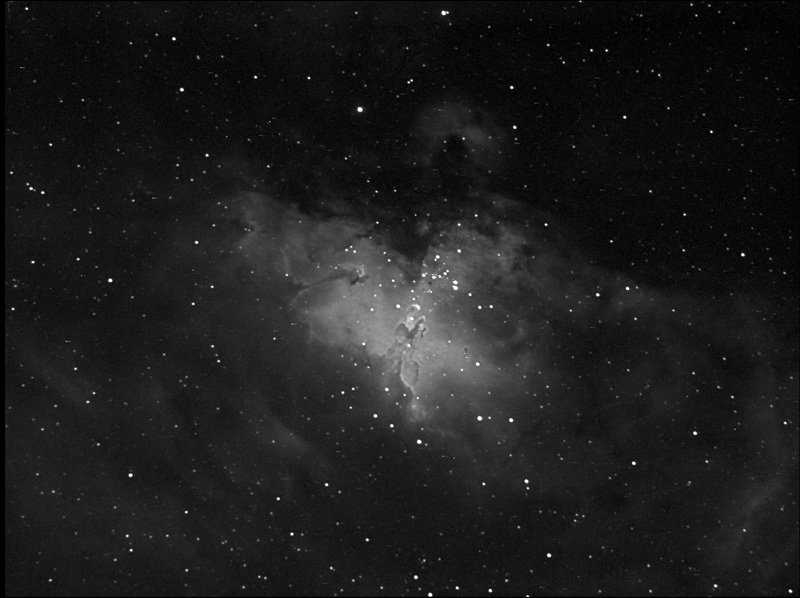

Image Centered on Ra. 18 : 18.8 (h:m) Dec. -13 : 47 (deg:m)
M16 (NGC 6611)
Information
(From the SEDS online web page)
Lying some 7,000 light years distant in the constellation Serpens, close to the
borders to Scutum and Sagittarius, and in the next inner spiral arm of the Milky
Way galaxy from us (the Sagittarius or Sagittarius-Carina Arm) a great cloud of
interstellar gas and dust has entered a vivid process of star formation. Open
star cluster M16 has formed from this great gaseous and dusty cloud, the diffuse
Eagle Nebula IC 4703, which is now caused to shine by emission light, excited by
the high-energy radiation of its massive hot, young stars. It is actually still
in the process of forming new stars, this formation taking place near the dark
"elephant trunks" which are well visible in our photograph, as well as in AAT
pictures and other images of M16. A deeper insight in the star formation process
could be obtained from the HST images of M16, published in November 1995;
moreover, they were used for an animation simulating the approach to this star
forming region, and we provide some screen sized images (suitable as backgrounds
for your computer screen).
This stellar swarm is only about 5.5 million years old (according to the Sky
Catalog 2000 and Götz) with star formation still active in the Eagle Nebula;
this results in the presence of very hot young stars of spectral type O6. The
cluster was classified as of Trumpler type II,3,m,n (Götz). The brightest star
of M16 is of visual magnitude 8.24. At its distance of 7,000 light years, its
angular diameter of 7 arc minutes corresponds to a linear extension of about 15
light years. The nebula extends much farther out, to a diameter of over 30',
corresponding to a linear size of about 70x55 light years.
Some sources have smaller distances for M16: Kenneth Glyn Jones gives 5,870.
Götz 5,540 light years. Götz states that this is one of the intrinsically most
luminous open clusters, at an absolute magnitude of -8.21.
While De Chéseaux, in 1745-6, only discovered the cluster. Charles Messier, on
his independent rediscovery of June 3, 1764, mentions that these stars appeared
"enmeshed in a faint glow", probably suggestions of the nebula. The Herschels
apparently didn't perceive the nebula, so that their catalogs and consequently,
the NGC, only describe the cluster. The nebula was added in the IC II of 1908 as
IC 4703, with "cluster M16 involved", but the NGC 2000.0 erroneously classifies
this object as an open cluster.
The nebula was probably first photographed by E.E. Barnard in 1895, and by Isaac
Roberts in 1897.
M16 is found rather easily, either by locating the star Gamma Scuti, a white
giant star of magnitude 4.70 and spectral type A2 III, e.g. from Altair (Alpha
Aquilae) via Delta and Lambda Aql; M16 is about 2 1/2 deg (19 min in RA) west of
this star. Or, in particular with a pair of binoculars, locate star cloud M24,
and move northward via a pair of stars of 6th and 7th mag, followed by small
open cluster M18 1deg North of M24, the magnificent Omega Nebula M17 another
1deg N, and finally another 2deg N, M16.
Star cluster M16 and the Eagle Nebula are best seen with low powers in
telescopes. A 4-inch reveals about 20 stars in an uneven background of fainter
stars and nebulosity; three nebulous concentrations can be glimpsed under good
observing conditions. Under very good conditions, suggestions of dark obscuring
matter can be seen to the north of the cluster. The Eagle nebula is best seen on
photographs, but larger apertures and nebula filters (O-III) may help to trace
some detail visually. The dark pillars can be seen in large amateur instruments
(12-inch up).
Optics and exposure info
Nikon Zoom lens at 500mm fl.
Mount, Losmandy G11 with Gemini control electronics
Imager, Starlite-Xpress SXV-h9 using Astronomiks RGB and Schuler Ha optical filters.
Exposure data, 90 min Schuler Ha Filter
Images acquired with Astroart and aligned then combined in Maxim Dl. Final RGB composite processed with Photoshop Cs
Images acquired from my backyard - " Dirt Clod Observatory" in Antelope California